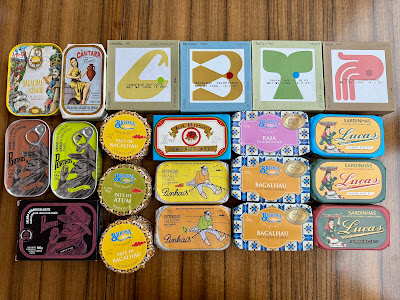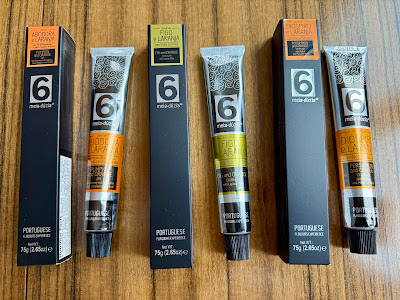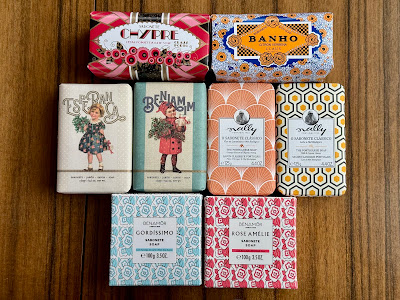Treats from Lisbon
We came back from Lisbon with lots of goodies, which were our mutual Christmas gifts. The canned seafood was a must-buy on this trip. We obtained 21 cans from 8 different brands: Briosa, Cantara, Comur, José Gourmet, La Rose, Lucas, Pinhais, and Porthos. A mix of old (e.g., Lucus, founded in 1896) and new (e.g., José Gourmet, founded in 2008) companies, and a variety of seafood, including salted cod, sardines, tuna, trout, octopus, horse mackerel, skate, and salmon. They have been a nice appetizer or a light dinner already. A couple of cans and a good baguette, maybe with a bowl of salad or soup... how simple it is!
The three mini bottles are three different brands of Portuguese liqueur made from sour cherries, Ginja, or formally known as Ginjinha. We also got Ginja-flavored cookies. They were crispy and lovely although I didn't find any existence of the sweet liqueur. The small glass cylinder is Portuguese bitter almond liqueur, which was sweet and intense, tasted like Italian amaretto. The Meia Serra Dão Reserve is a Portuguese red wine that the lady at the wine store recommended to J. He looks forward to an opportunity to open it.
The sweet orange with Vinho Licoroso, or fortified wine was a nice marmalade that was unexpectedly perfumy. Geleia de marmelo (quince jelly) is very sweet with hint of bitterness, somewhat like caramel. The complicated taste was new for me, but I am beginning to like it as I try it more.
We found a store of meia.dúzia by chance while we wandered around the city center of Lisbon. First I thought the store was selling cosmetics or something because many toothpaste-like tubes were lined up in the store. Founded by two siblings in 2012, meia.dúzia is a company specialized in production of artisanal jams, chocolate creams, sauces, olive pastes, and honey - traditional flavors from Portugal - in tubes.
We sampled several jams and picked three: pumpkin and orange jam with rosemary and eucalyptus honey, cinnamon and almond; Fig and orange extra jam with liqueur wine; and persimmon and range extra jam with walnut and muscatel wine. We haven't opened the tubes yet. The store guy suggested to pair those jams with cheese, but we might simply enjoy squeezing them on a toast.
The chocolate bars from Chocolataria Equador were thick and heavy. I knew why when I tried to cut the bars. Those bars were generously filled with creamy ganache. We had two bars. One was dark chocolate (67% cacao) with sour cherry liqueur ganache; the other was white chocolate with passion fruit ganache. Both were splendid. We also had two kinds of pralines: yuzu & cinnamon and... I don't remember but praline & allspice, maybe? They were wonderful, too. All those chocolates disappeared rapidly.
I picked up two brands of Portuguese premium sea salt. Both were hand-harvested in the Algarve region of Portugal. I tasted Marisol's a bit. Well, it was salty and definitely it was salt.
J picked Trás-os-Montes DOP Olive Oil. The Trás-os-Montes is a mountainous region of northeastern Portugal, bounded north and east by Spain. The olive oil from the region is often described as a well-balanced, sweet, intense, fresh, fruity, mildly bitter and slightly spicy. We haven't tried it yet but we will soon.
Three kinds of traditional Portuguese sausages also traveled home with us. Both Linguiça Fina de Barrancos (Barrancos thin sausange) and Chouriço de Barrancos (Barrancos chorizo) are dry-cured sausages from Barrancos, a village in the Alentejo region of southern Portugal. They were made with black pork, seasoned with salt, garlic, paprika and sweet pepper. I used them to make homemade tomato pasta sauce and homemade Hungarian sauerkraut soup. Both brought a nice, meaty flavor to the dishes. I think both had a similar taste and neither was spicy. Alheira de Mirandela Certificada (Certified Mirandela Sausage) was a smoked sausage, produced exclusively in the municipality of Mirandela in northeastern Portugal, made with mostly chicken meat, some Bísaro pork (native breed), regional wheat bread, meat cooking broth, Trás-os-Montes DOP olive oil, salt, lard, and spices. It's fresh, so you need to cook it before eating. Google told me that pan-flying is a common way to cook the particular sausage, so I did. The sausage tasted ok but its texture was a surprise. There was no bite, just like soft paste!
We welcomed four kinds of cheese from Lisbon home:
1. Queijo de Ovelha was handcrafted by Manteigaria Silva, the delicatessen that we bought it as well as the three sausages. It's a semi-hard, creamy sheep's milk cheese coated with orange wax. I think J chose 4 months matured one, medium sharp. The delicatessen also offers Queijo de Ovelha younger as well as 8 months matured.
2. São Bento is a sheep's raw milk cheese with orange rind in the Alto Alentejo region. It had the strongest ripened smell of the four.
3. Cabra Artesanal Soalheira is a goat's raw milk, semi-hard cheese from the Serra da Gardunha region. Lovely creamy and perhaps my favorite among them.
4. São Jorge Edição Especial is a cow's raw milk cheese produced in the island of São Jorge, one of the Azores islands, a Portuguese archipelago in the mid-Atlantic. The cheese we bought was over 30 months matured. Perhaps because of the very long maturation, it was very sharp and spicy as if it was made with red chili pepper. I have never had a peppery cheese that stung my tongue like that. The texture was similar to that of Parmigiano Reggiano.
What our first Portuguese delicacy tasting party looked like...
Four scones (two plains and two with raisins) from Confeitaria Nacional were our breakfast the day after returning home. They were good but not as good as Bettys' in Harrogate. I miss the scone culture of UK!
Confeitaria Nacional's Bolo Rei or Kings Cake was sweet bread rather than cake. The dough was pretty simple and not so sweet. The sugary top with candied fruits was the best part to nibble!
This was the Alcoa's box that I carefully carried home from Lisbon. Gladly the seven pastries in the box remained intact.
Each one looked different but almost all were made with almond and Doce de Ovos, Portuguese sweet egg yolk cream. Therefore they had a sort of similar taste but somehow they distinguished from others by additional ingredients (pumpkin, squash, apple, walnuts, spices, etc), shape and texture. In short, I liked all very much!
These are not edible but luxurious treats for us. We bought total eight Portuguese soaps of four different brands. We sniffed many soaps during our shopping time to find our favorites. The eight soaps were our perfect stocking stuffers although they were a little heavy to make our knitted stockings stretched out. We are using one currently and it foams lovely and smells wonderful!
The eggplant shaped bowl is also not edible but would hold something edible. This was my first dish from Bordallo Pinheiro, a Portuguese ceramic brand that I have been interested in. Bordallo Pinheiro was founded in 1884 by Raphael Bordallo Pinheiro, one of the most noteworthy and most adaptable Portuguese artists of the 19th century. A unique blend of creativity, naturalism and humor has been the brand's identity, which I can see in my cute eggplant bowl. By the way the bowl is supposed to be a small salad bowl. It's pretty deep and large. The first role of the eggplant was to be a bread bowl.
How could I expect that one eggplant became twins. Some days later another bowl arrived home, which J bought secretly after our return. Now we have two bowls and we are using them as a pasta bowl sometimes. They are in right size to serve pasta. All items from Bordallo Pinheiro are handmade. They looked slightly different, which gives them their own personalities.
I have no doubt that Lisbon was a delightful destination during the holiday season!




















